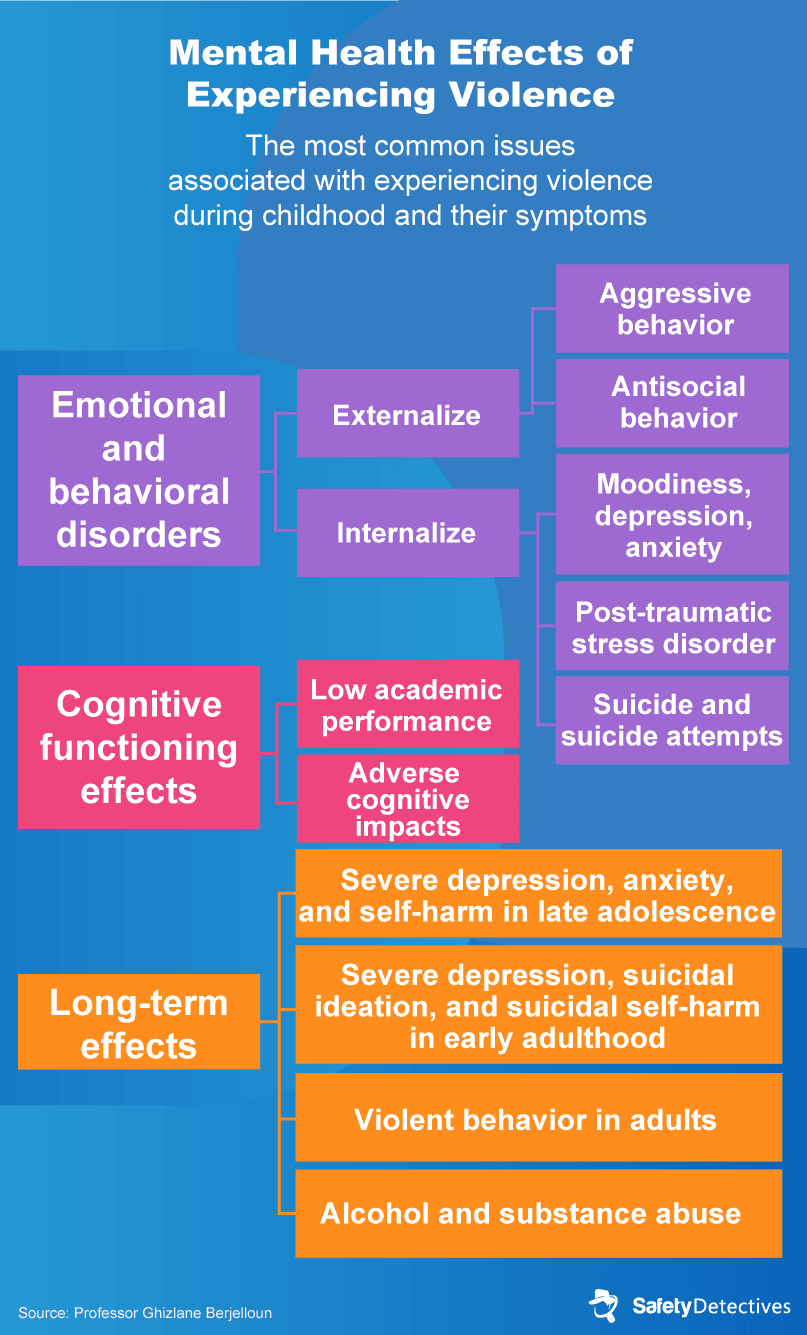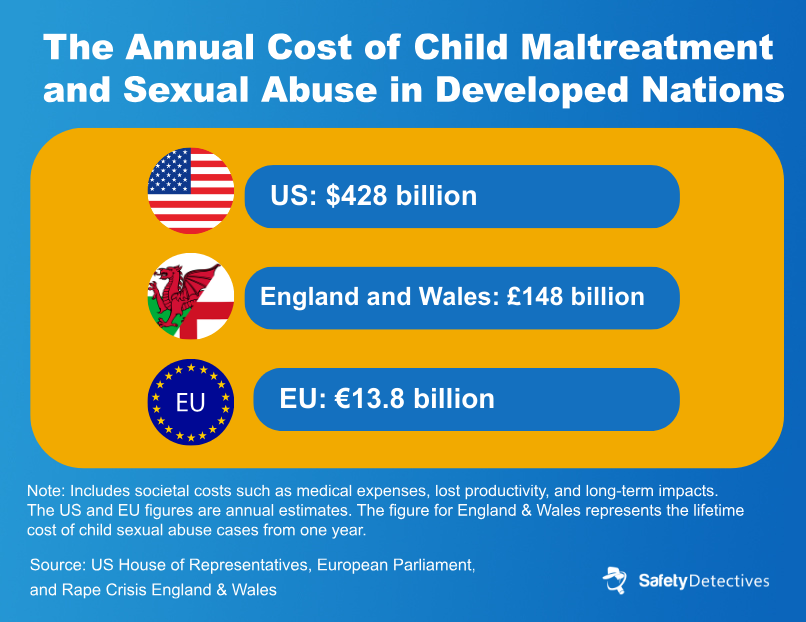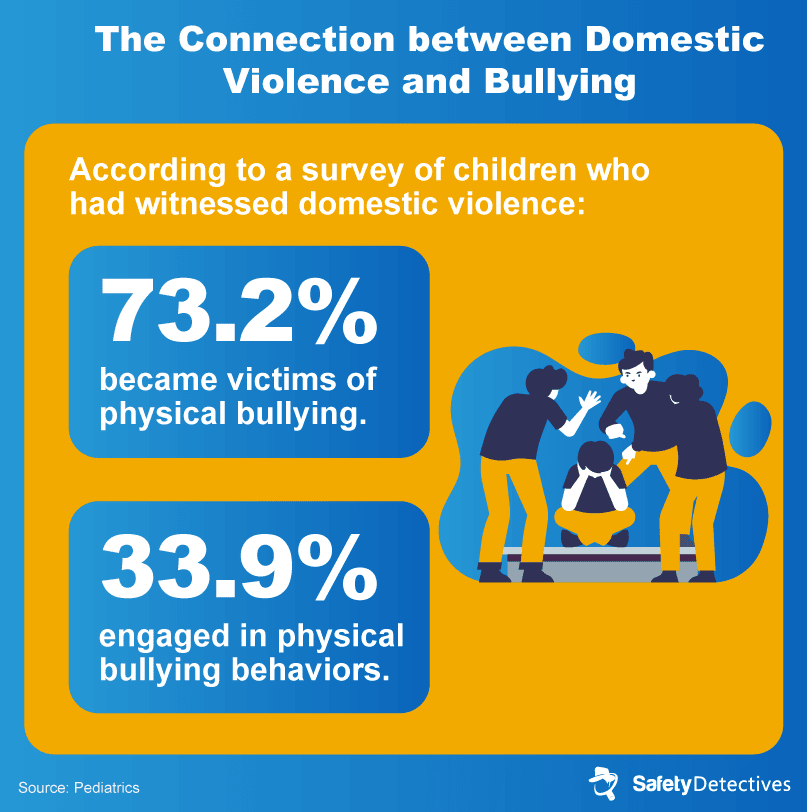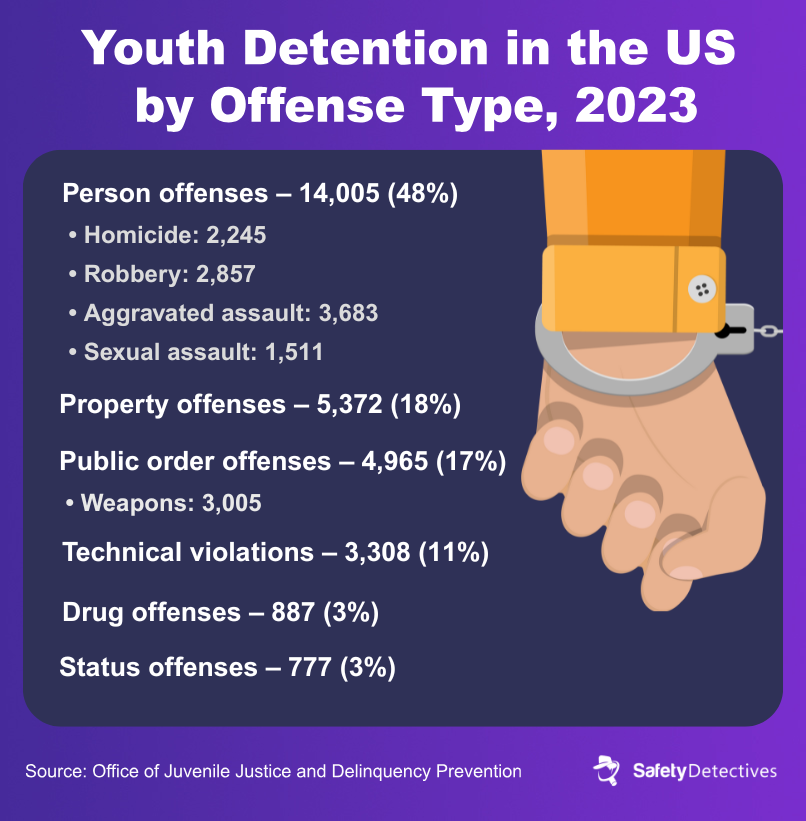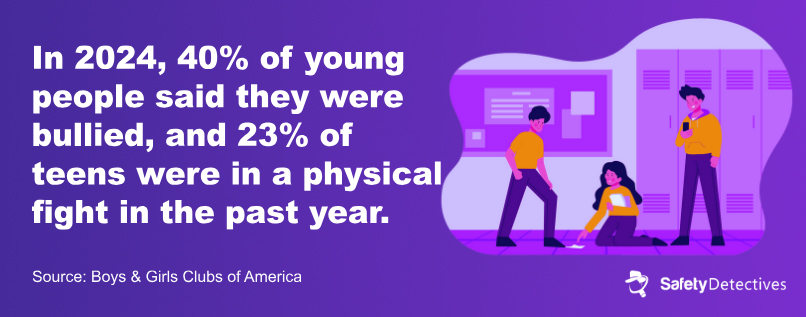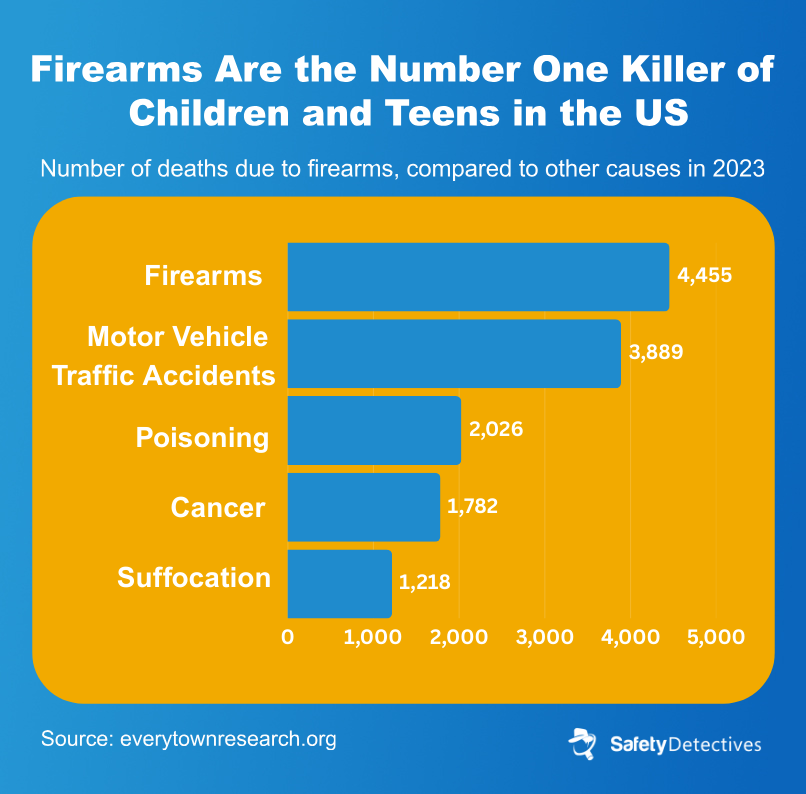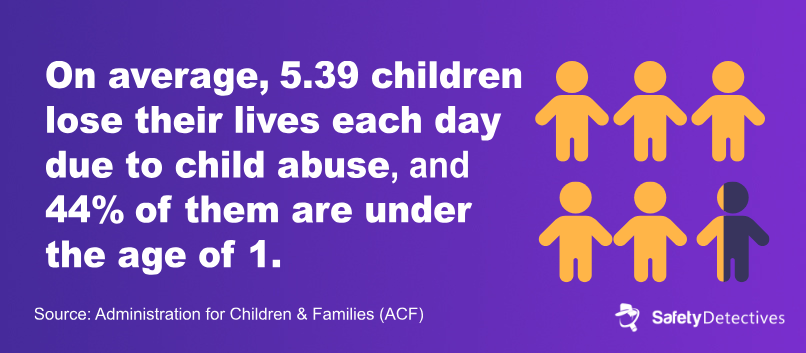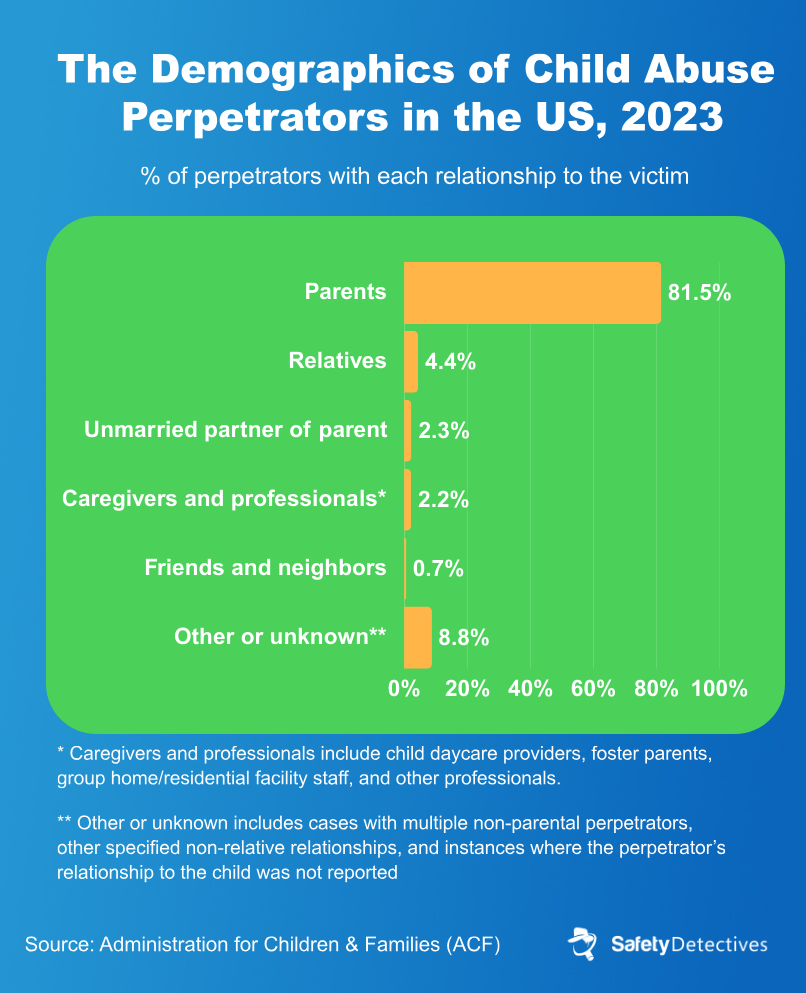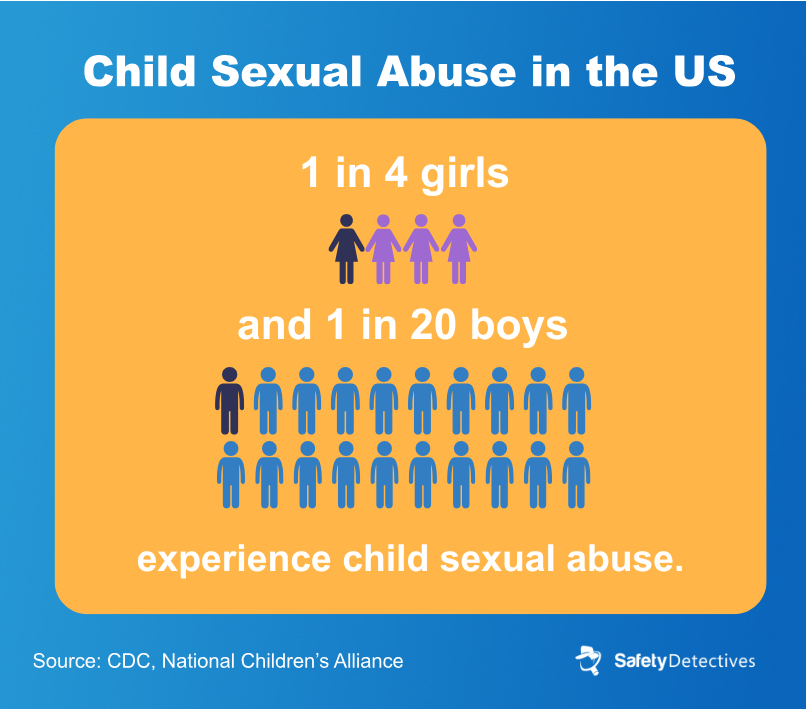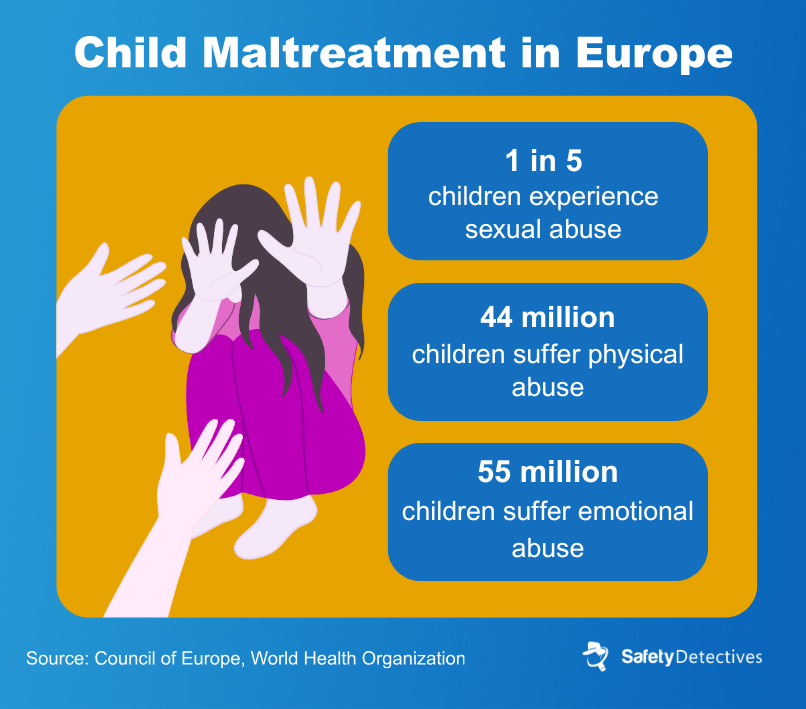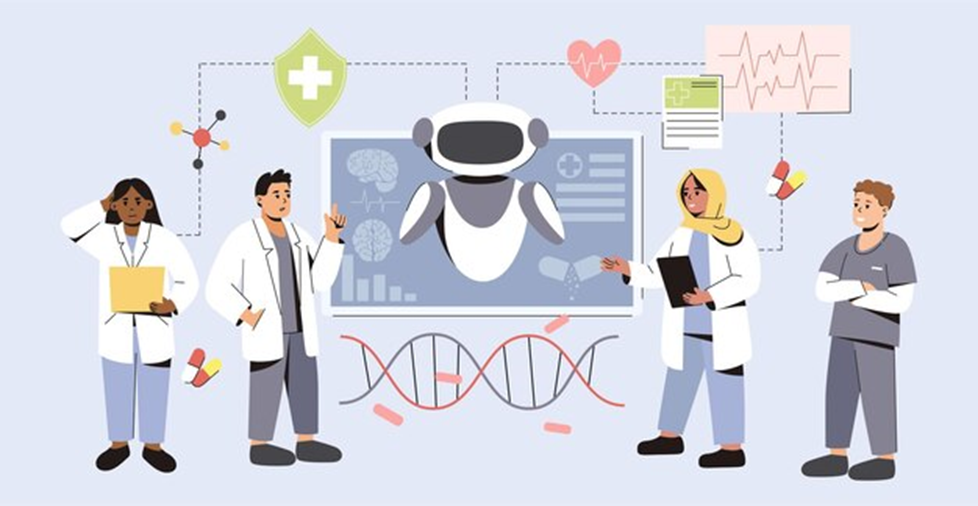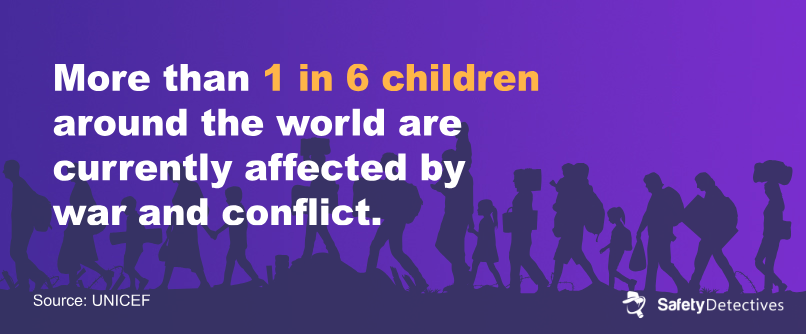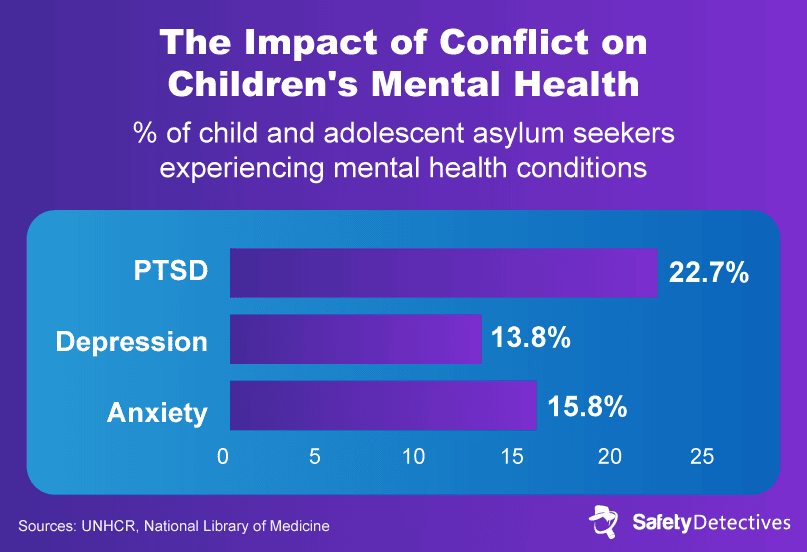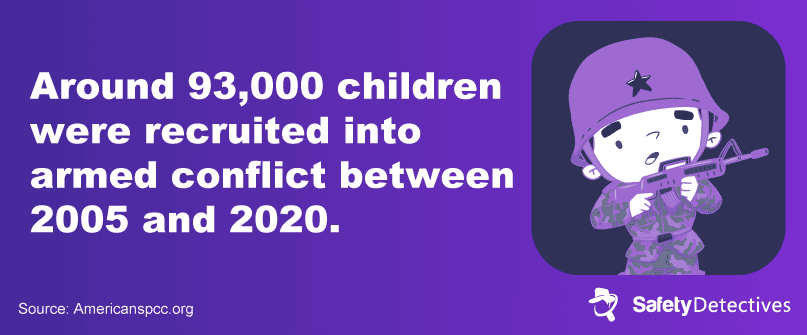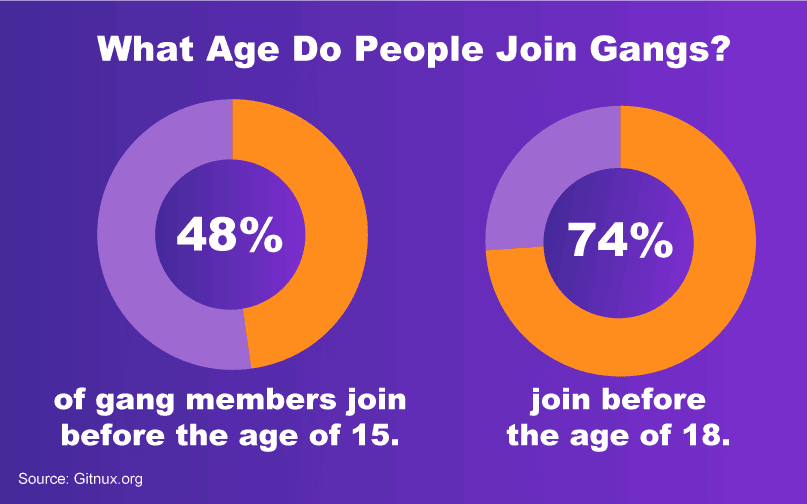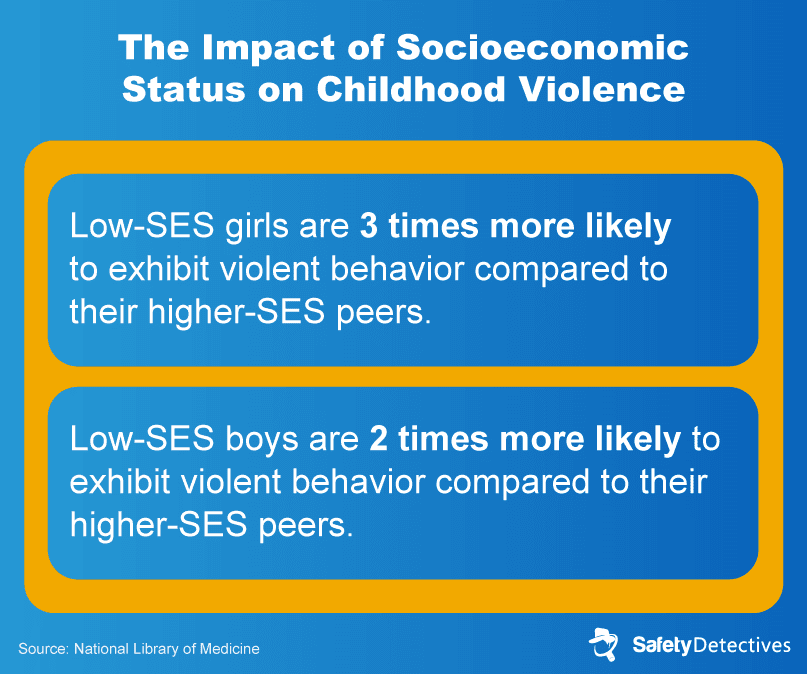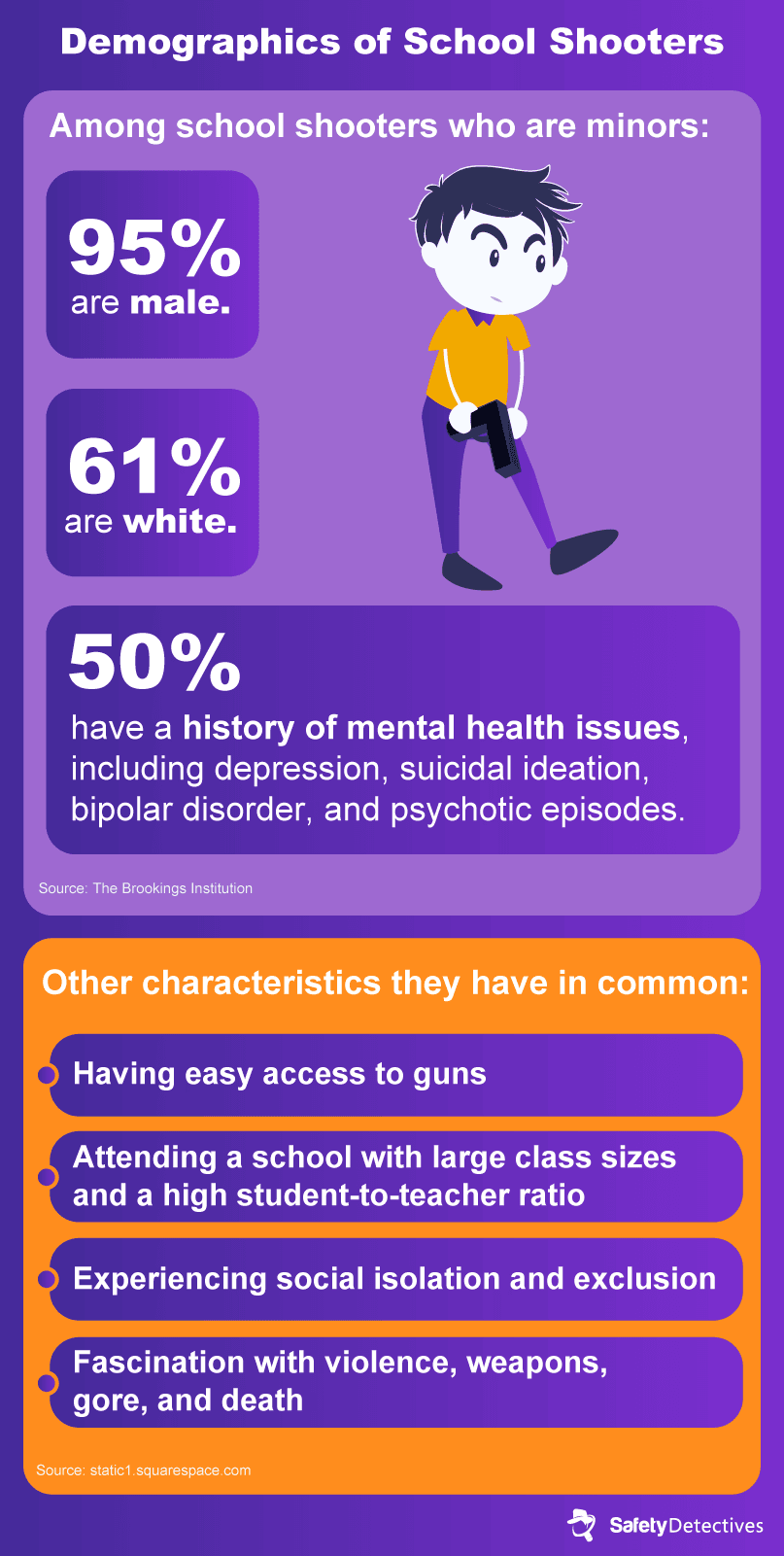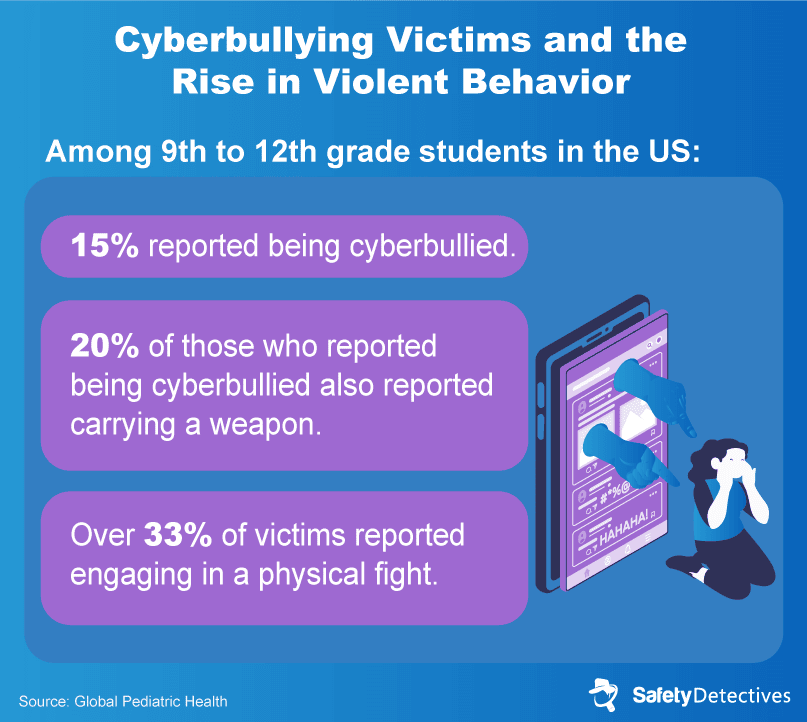Maria Fernanda Rincon
Updated on: September 19, 2025
Violence amongst children is an unfortunate issue with devastating consequences. This type of violence is a public health, social, and human rights issue that can affect a person’s mental health for decades after they’ve been vicitimized.
To help you learn more about this topic, I’ve gathered together the most important statistics on violence among children found anywhere on the internet. You’ll learn about the prevalence, impact, and various predictors of youth violence, as well as proven ways to prevent violence among children.
Most of the statistics included here come from census data and other large government studies. Since these sources are not published on a yearly basis, the figures reflect the most recent data available, which may not include 2024 or 2025.
If you or someone you know is a victim of child abuse or another form of violence, contact the US National Child Abuse Hotline at 800.422.4453 or via Childhelp’s website.
What Exactly Is Youth Violence?
The WHO defines youth violence as physical acts of aggression inflicted upon individuals who are 10 to 29 years old. However, the vast majority of this article’s statistics apply solely to children and adolescents under 18 years old.
In this article, the term “violence” encompasses physical aggression, such as hitting, kicking, beating, physical bullying, sexual abuse, physical harassment, or the use of weapons or objects to inflict harm. It does not include verbal abuse, emotional abuse, grooming, verbal- and cyber-bullying, or hate crimes.
While these acts are detrimental to the well-being of children and have unfortunate long-term consequences, there’s no physical violence in this act. The focus is on actions that use physical force to harm, damage, or kill someone.
It’s also important to distinguish between childhood violence and adverse childhood experiences (ACEs).
While the former refers to physical harm inflicted on children or adolescents by adults, peers, or through societal structures, ACEs encompass stressors that children might face while growing up. This includes witnessing violence at home or in their community and dealing with family issues like parental substance abuse.
Section 1: Impacts of Experiencing Youth Violence
Children who have been victims of violence or perpetrated it are at risk of developing unhealthy behaviors that could lead to serious mental health issues. In this section, we take a detailed look at what exactly these consequences are and how they come about.
#1: Mental Health Effects of Experiencing Violence
Violence can have severe impacts on children’s mental health. It can lead to behavioral and emotional disorders, such as aggression and antisocial behavior, as well as anxiety, depression, post-traumatic stress disorder (PTSD), and suicidal thoughts.
These experiences can affect cognitive functioning, resulting in poor academic performance and negative thinking. For some children, the long-term effects can be even more profound, leading to problems such as persistent depression and anxiety, as well as self-harm, adult violence, and substance abuse.
#2: Victims of Violence Are Less Socially Active and Perform Poorly in School
Adverse childhood experiences undermine a child’s sense of safety in their relationships, which can lead to difficulties in forming and maintaining social connections later in life. Experiencing abuse can lead to feelings of guilt, shame, anxiety, and symptoms of PTSD, which can disrupt children’s ability to concentrate and participate in school activities.
Victims may experience a decrease in their motivation and find it difficult to form relationships with their peers. They may also struggle with sleep disturbances and a lack of interest in playing or exploring new interests, which further hinder their academic and social development.
#3: The Monetary Costs of Sexual Violence against Children
Various studies confirm that violence in childhood can lead to increased use of health services and other resources that impact government spending. Billions are spent as a result of treating and rehabilitating children after incidents of sexual violence.
Children who’ve experienced sexual abuse have double the risk of developing mental health conditions and often face teen pregnancy as well as sexually transmitted diseases, all of which add to a nation’s annual costs.
#4: Victims of Childhood Violence Are More Likely to Experience Poverty in Adulthood
Adults who have been sexually or physically abused as children are more likely to live below the poverty line. There are several reasons why this happens.
These individuals may struggle at school because of their trauma, which limits their job opportunities when they are adults. At the same time, some people who were physically abused as children experience long-term mental health issues and behavioral problems, which affect their ability to maintain a stable job or persue better work opportunities.
#5: Witnessing Violence and Bullying Are Closely Connected
According to the “cycles of violence” theory, children who are exposed to violent behaviors at home are likely to display similar behaviors both in childhood and adulthood. A study from the University of Washington and Indiana University confirmed this.
The study also found that although children exposed to intimate partner violence were not more likely to engage in relational bullying, they were more prone to show problematic behaviors such as physical aggression and internalizing issues like anxiety or depression.
Section 2: The Current State of Youth Violence
The landscape of youth violence in the 2020s is a whole lot different than it was just a couple of years ago. While there have been certain positive developments, youth-on-youth violence is still a large-scale issue.
#6: The Number of Youth in Detention
In 2023, more than 29,000 youth were held in detention facilities across the US. Nearly half (48%) were detained for violent person offenses — which includes aggravated assault, robbery, sexual assault, and homicide.
Drug offenses and status offenses — like truancy, running away, or curfew violations — accounted for only a small fraction of detentions. On the other hand, public order offenses, including weapons violations, made up 17% of detentions.
#7: Many Young People Report Being Bullied at School
A survey conducted by the Boys and Girls Club of America in 2024 found that 40% of young people were bullied on school property and 23% of teens had been in a physical fight in the past year.
Bullying has long-term impacts on young people’s mental, physical, and emotional health. Students who are bullied are more likely to suffer from depression, anxiety, and sleep problems as well as lower self-esteem.
#8: Firearms Are the Number 1 Killer of Children and Teens in the US
Firearms are the leading cause of death for children in the US, according to a 2024 study. 4,455 children were killed in incidents involving firearms, including murders, suicides, school shootings, and accidental injuries resulting in fatalities.
Boys account for 83% of all gun deaths among children and teens. Age is also a key differentiator; children aged 12 to 17 account for 86% of all victims.
The most stark comparison can be drawn along racial lines. Black children and teens constitute 46% of gun deaths among children and teens, despite making up just 14% of the under-18 population in the US.
#9: The Scale of Children Dying From Physical Abuse
On average, just over five children die from child abuse each day. 44% of these victims were under the age of one. Two-thirds of victims were under the age of three.
At least one parent was involved in 81.5% of child fatalities resulting from child abuse in 2023. According to the Mayo Clinic, the risk factors that perpetuate these problems range from alcohol, drug, and other substance abuse to financial problems, unemployment, and poverty.
#10: The Majority of Abusers Are Caregivers
According to the Administration for Children & Families, the majority of child abuse cases involve perpetrators who are parents of the child, accounting for 81.5% of cases in 2023. Non-parent relatives (4.4%) and individuals with personal relationships with the child – such as unmarried partners of the child’s parents (2.3%) and friends or neighbors (0.7%) – are also regular perpetrators of abuse. The remaining percentage includes caregivers, childcare providers, foster parents, group home staff, legal guardians, and others.
Family violence is a particularly difficult challenge because it’s almost impossible for children to escape since these are the people they depend on to take care of them (i.e., their parents, babysitters, siblings, etc.).
Section 3: Youth Violence around the World
Violence is one of the most common offenses committed by minors all over the world. Many children and teens experience violence that never ends up on the record.
In this section, we’ll take a closer look at the causes of youth violence around the world.
#11: Child Maltreatment in the US Often Involves Physical and Sexual Abuse
An estimated 1 in 4 girls and 1 in 20 boys in the US experience child sexual abuse, according to the CDC.
Aside from immediate physical harm, these forms of abuse can also cause emotional trauma that leads to long-term problems, including anxiety, depression, and post-traumatic stress disorder (PTSD).
#12: Child Maltreatment in Europe
According to the European Parliament, in Europe, one in five children are estimated to be victims of some form of sexual violence, and between 70% and 85% of child victims know their abuser. A third of abused children never tell anyone about the abuse.
According to WHO, an estimated 18 million children in Europe suffer sexual abuse, 44 million physical abuse, and 55 million emotional abuse before the age of 18. This results in the deaths of at least 850 children under 15 on the continent annually.
#13: Young People in the UK Are Perpetrating More “Violence against the Person”
The total number of crimes committed by young people aged 10 to 17 years old in the United Kingdom has decreased over the past decade. However, there has been a significant increase in violent crime committed by children in England and Wales over the last decade.
Specifically, the proportion of violence against the person offenses has increased by 12.5 percentage points. This category includes serious crimes like homicide, rape, and aggravated assault. Additionally, sexual offenses have seen a rise of 2.1 percentage points, and motoring offences of 4.6 percentage points.
#14: Juveniles Are the Largest Segment of Violent Crime Suspects
In 2024, there were 65,070 violent crime suspects under the age of 21 in Germany, according to the Federal Criminal Police Office.
The data show that juveniles (14 to 17 years old) had the largest share, with 31,383 suspects, followed by young adults (18 to 20 years old) with 19,912. Children under the age of 14 accounted for 13,775 suspects, a number that remains significant compared to other forms of youth violence.
Section 4: The Impact of Children Being Exposed to Widespread Violence
War, terrorism, and gangsterism are some of the most extreme forms of violence that anyone can be exposed to. This section sheds light on the impact and consequences of this type of violence on children.
#15: Hundreds of Millions of Children Live in Conflict Zones
According to UNICEF, over 473 million children (more than 1 in 6 globally) live in conflict zones, which are defined as areas within 50 km of armed violence. This figure has doubled since the 1990s and is now at the highest level recorded since World War II.
In these areas, education is highly disrupted, and more than 52 million children are out of school, with some missing more than a year of education due to damage, destruction, or military use of schools. Regions like Gaza, Sudan, Ukraine, and the Democratic Republic of Congo are among the most affected.
#16: Children Affected by War and Terrorism Develop Mental Health Problems
By the end of 2024, a record 48.8 million children lived in forced displacement due to conflict and violence. According to the UN Refugee Agency, children make up 29% of the world’s population, but account for 40% of all forcibly displaced people.
The traumatic experiences, fear, and uncertainty that result from war drive depression and anxiety among children affected by conflict. Physical injuries, social isolation, and economic hardship further contribute to these mental health struggles.
Early studies show a significant increase in PTSD soon after resettlement, but rates of depression and anxiety also increase within five years. These findings highlight the critical importance of both immediate and long-term mental health care for war-affected children and families and underscore the need for support during and after traumatic events.
#17: Thousands of Children Are Recruited by Armed Groups
Since 2005, approximately 105,000 children were verified as recruited and used by armed groups, according to UNICEF, though the real figure is likely much higher.
In the first two months of 2025 alone, more than 400 children in the Democratic Republic of Congo were recruited by armed actors, with some as young as 14 years old. Other recent reports indicate a 70% rise in child recruitment by armed groups in Haiti between 2023–2024, along with hundreds of confirmed cases in Colombia, some even involving recruitment at schools or through social media.
Historically, children have always been involved in war, but modern conflicts see a disturbing number of children being recruited. Children are targeted because they can easily be manipulated or forced into joining armed groups. They also don’t require as much food as adult soldiers.
#18: Most Minors Stay in Gangs for 4 Years or Fewer
A common misconception perpetuated by pop culture is that leaving a gang is impossible. In reality, however, most members can quit without any major issues. In a survey of former gang members, 91% said they had “just left their gang and did not have to engage in any exceptional means to quit.”
Youths usually stay in gangs for two years or less, and only around 10% stay in gangs for more than four years. The most common reason young people leave gangs is because of their experiences with violence.
#19: Most Gang Members in the US Join Organized Crime Groups in Their Teens
Only 2% of all gang members are juveniles, but most older affiliates report having joined these organizations when they were minors.
Research suggests that social, family, and community environments can all impact a youth’s likelihood of joining a gang. Youths who associate with delinquent peers, experience negative life events, and hold positive attitudes toward drugs are at risk. However, no single factor, or set of factors, can fully predict whether someone will join a gang.
Meanwhile, youths with strong social competence, close social connections, and conventional beliefs are less likely to join gangs.
Section 5: Risk Factors for Youth Violence
There is no single factor that fully explains why some young people engage in or experience violence. It results from many interacting elements, including family dynamics, school climate, and community environment.
#20: Socioeconomic Risk Factors
Young people from lower socioeconomic backgrounds (Low-SES) are more likely to be exposed to violence and, therefore, exhibit violent behaviors later in life. A study found that female teenagers from low socioeconomic backgrounds were three times more likely to engage in violent behavior than others, while boys were twice as likely.
This difference between the genders may exist because girls tend to internalize stress and trauma differently than boys. This could lead to higher rates of violent behavior as a means of coping with these experiences.
#21: Common Denominators of School Shooters
Most school shooters are young, male, predominantly white, and often feel marginalized, with many experiencing bullying or rejection. More than half have mental health problems such as depression or suicidal thoughts. Many also show a fascination with violence, often reflected in their media consumption and personal writings.
Since most school shooters are minors and obtain guns illegally, often from family members, tightening gun control is essential. Schools must also pay close attention to warning signs of impending violence and encourage students and staff to report potential threats.
#22: Cyberbullying Increases the Risk of Physical Violence
A study has found that cyberbullying victims are significantly more likely to become violent than their peers who were not bullied. These victims might resort to physical violence with the use of a weapon as a way of retaliation against their bullies.
Only 22.5% of non-victimized students reported being in a physical fight and 16.2% admitted to carrying weapons, compared to 33% and 20% of those who had been cyberbullied. In the US, cyberbullying is now more common than in-school bullying.
Section 6: The Best Ways to Mitigate Violence among Children
Physical violence among children is common, but not unavoidable. With the right psychological care, classroom practices, and child-parent conversations about managing anger, the likelihood of a child being violent can be radically decreased.
1. Child-Parent Center Programs
In Scotland, children who started Child-Parent Center programs at ages 3 or 4 and stayed for 4 to 6 years had lower rates of violent arrests and convictions 15 years later. The longer they stayed in the program, the less likely they were to be involved in violent crime.
These programs involved both the children and their parents, with the goal of reducing violent behavior. And it looks like the benefits of these programs lasted long after they ended. Implementing such programs can really make a dent in the overall level of violence.
2. Mentoring
After just 18 months in a mentoring program, children were 46% less likely to start using illegal drugs, 27% less likely to start drinking alcohol, and 32% less likely to get into physical fights.
Mentoring really helps. When children have trusted mentors close to their age, they do better at handling tough issues and experiences, and managing difficult emotions. These programs also provide a safe space for children to express themselves and learn better coping skills.
3. Educational Programs and Training
G.R.E.A.T. (Gang Resistance Education and Training) is a program that teaches middle school students in the US to avoid gang involvement, reduce delinquency, and improve attitudes toward police.
This program has shown promising results with a 24% reduction in youth gang membership rates among students. Youths who participated showed positive changes in several areas, including more positive attitudes toward police, less positive attitudes about gangs, stronger refusal skills, greater resistance to peer pressure, and fewer associations with delinquent peers.
These findings suggest that G.R.E.A.T. is effective in influencing key factors associated with gang membership and can be an essential component of community strategies to prevent youth violence and gang involvement.
4. Local Programs and Strategies
The WHO’s INSPIRE strategies are making a real difference in reducing violence against children. Analysis shows that well-designed local INSPIRE programs can reduce violence by as much as 20-50%.
INSPIRE stands for implementation and enforcement of laws, norms, and values; safe environments; support for parents and caregivers; income and economic empowerment; response and support services; and education and life skills.
Each of these elements is critical, and while some communities may be stronger in certain areas than others, they all must work together. When they do, they create safer, more nurturing environments where young people can truly thrive.
The Bottom Line
Violence among children is a complex, multi-layered issue. Children can be victims or perpetrators of violence. Often, they’re both at the same time. Regardless of their role, violence can impact children long into adulthood, both physically and mentally.
Current trends suggest that violence among children and teens is decreasing, but that doesn’t mean they’re not exposed to it anymore. With social media and the internet, children today are able to access violent images much easier than in generations past.
While this is worrying, parents, teachers, and caregivers aren’t helpless in the fight against youth violence. Youth programs have shown that education and compassion are effective ways to reduce the likelihood of kids and adolescents becoming violent. As adults, leading by example and creating supportive environments for children can help keep them on the right path.


